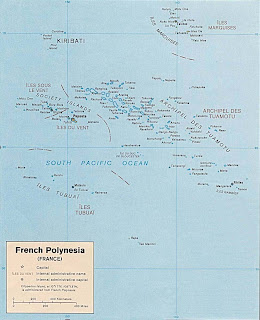French Polynesia is a sprawling possession of France in the Pacific Ocean, made up of 118 volcanic and coral islands and atolls, including Tahiti.
For France this huge stretch of the Pacific - as big as Western Europe - remains strategically valuable. Atomic testing on the atolls enabled France to keep the nuclear clout it needed to remain one of the world's leading powers.
The issue of independence dominates the political agenda.
Overview
There are five island groups - the Society islands, the Tuamotu archipelago, the Gambier islands, the Marquesas islands and the Tubuai islands. Tahiti is the most densely-populated island.
European contact was gradual; the Spanish, Portuguese, Dutch and British were credited with the discovery of one or more of the islands. In the 18th century European traders and missionaries came, bringing diseases which wiped out much of the indigenous population.
The missionaries tried to put a stop to local religious practices, nudity and other aspects of indigenous life. Some forms of Polynesian culture were lost for many years.
Tahiti, in the Society islands, became a French colony in 1880. France later annexed other islands to form the French Colony of Oceania. In 1946 the islands became an overseas territory and in 2004 gained "overseas country" status.
Pro-independence movements flourished in the 1970s and over time the islands took more control of internal affairs, culminating in a statute granting increased autonomy in 1996.
There has been friction with Paris over nuclear testing. France conducted 41 atmospheric tests on the Mururoa atoll and neighbouring Fangataufa from 1966. In 1975, under international pressure, it switched to underground tests.
Ending a three year moratorium, French President Jacques Chirac said testing would resume in 1995. The move provoked international anger and protests in Papeete turned violent.
Six of the eight planned tests were carried out, the last one in January 1996. At the end of the programme Paris agreed to a 10-year compensation package.
In 1995 the UN's nuclear watchdog concluded that radiation levels around the atolls posed no threat. In 1999 Paris admitted that fractures had been discovered in the coral cone at the sites. The atolls continue to be monitored.
In March 2009, the French government enacted legislation to allow compensation for former workers at France's nuclear weapons test sites.
French Polynesia enjoys a high standard of living, but wealth is unevenly distributed and unemployment is high.
Tourism is an important money-earner; travellers favour Tahiti and Bora Bora. Boasting a year-round warm climate, volcanic peaks and tranquil lagoons, it is easy to see why the islands are popular. French Polynesia is, though, prone to typhoons.
Facts
* Territory: French Polynesia
* Status: French overseas territory
* Population: 270,764 (World Bank, 2010)
* Capital: Papeete, on Tahiti
* Area: 4,167 sq km (1,609 sq miles)
* Major language: Tahitian and French
* Major religion: Christian
* Life expectancy: 73 years (men), 78 years (women)
* Monetary unit: Pacific franc
* Main exports: Cultured black pearls, fish and coconut products
* GNI per capita: $16,540 (World Bank, 1999)
* Internet domain: .pf
* International dialling code: + 689
Leaders
Head of state: (French) President Nicolas Sarkozy, represented by a high commissioner
President: Oscar Temaru
French Polynesia has a 57-member assembly which is elected every five years. The president is elected from the assembly. France retains responsibility for foreign affairs, defence, justice and security. The territory is represented in the French parliament by two deputies and a senator. It is represented at the European Parliament.
From : BBC News


